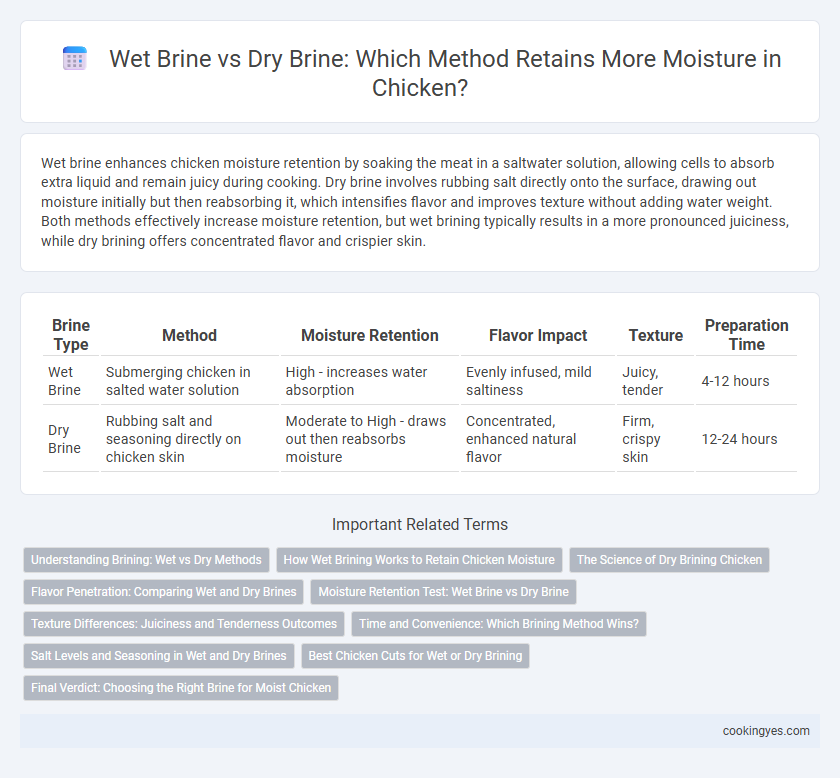Wet brine enhances chicken moisture retention by soaking the meat in a saltwater solution, allowing cells to absorb extra liquid and remain juicy during cooking. Dry brine involves rubbing salt directly onto the surface, drawing out moisture initially but then reabsorbing it, which intensifies flavor and improves texture without adding water weight. Both methods effectively increase moisture retention, but wet brining typically results in a more pronounced juiciness, while dry brining offers concentrated flavor and crispier skin.
Table of Comparison
| Brine Type | Method | Moisture Retention | Flavor Impact | Texture | Preparation Time |
|---|---|---|---|---|---|
| Wet Brine | Submerging chicken in salted water solution | High - increases water absorption | Evenly infused, mild saltiness | Juicy, tender | 4-12 hours |
| Dry Brine | Rubbing salt and seasoning directly on chicken skin | Moderate to High - draws out then reabsorbs moisture | Concentrated, enhanced natural flavor | Firm, crispy skin | 12-24 hours |
Understanding Brining: Wet vs Dry Methods
Wet brine uses a saltwater solution that penetrates chicken, enhancing moisture retention through osmosis and muscle fiber relaxation. Dry brine involves rubbing salt directly onto the chicken's surface, drawing out moisture that then reabsorbs, intensifying flavor and juiciness without additional water. Both methods improve chicken's tenderness and moisture, but wet brining can add extra weight while dry brining yields a firmer texture and concentrated taste.
How Wet Brining Works to Retain Chicken Moisture
Wet brining enhances chicken moisture retention by soaking the meat in a saltwater solution, which causes cells to absorb and retain extra water molecules. The salt in the brine also denatures muscle proteins, allowing them to hold onto moisture more effectively during cooking. This process results in juicier, more tender chicken by minimizing water loss and enhancing the overall texture.
The Science of Dry Brining Chicken
Dry brining chicken enhances moisture retention by allowing salt to penetrate the meat deeply, breaking down muscle proteins and improving water absorption. This process creates a semi-permeable layer that traps juices during cooking, resulting in juicier and more flavorful chicken. Scientific studies confirm dry brining's effectiveness in maintaining optimal internal moisture compared to wet brining, which can sometimes cause water loss during cooking.
Flavor Penetration: Comparing Wet and Dry Brines
Wet brines enhance flavor penetration by immersing chicken in a saltwater solution, allowing deeper absorption of seasonings and moisture for juicier meat. Dry brines, using salt and spices directly on the chicken's surface, draw out moisture initially and then reabsorb it, concentrating flavors and improving skin crispness. Both methods effectively increase flavor depth, but wet brining offers thorough seasoning diffusion while dry brining intensifies savory notes with a firmer texture.
Moisture Retention Test: Wet Brine vs Dry Brine
Moisture retention tests comparing wet brine and dry brine on chicken show that wet brining typically results in higher overall water absorption due to the saltwater solution penetrating the meat fibers. Dry brining enhances moisture retention by drawing juices to the surface, creating a concentrated salt layer that reabsorbs moisture, leading to a more flavorful and juicier chicken without added water weight. Scientific measurements indicate that while wet brine increases moisture content by up to 10-15%, dry brine maintains comparable juiciness with improved texture and seasoning concentration.
Texture Differences: Juiciness and Tenderness Outcomes
Wet brining chicken involves soaking it in a saltwater solution, which enhances moisture retention by allowing the meat to absorb extra water and salt, resulting in a juicier texture. Dry brining relies on applying salt directly to the chicken skin, drawing out moisture that reabsorbs with dissolved salt, intensifying flavor and producing a firmer, more concentrated tenderness. Wet brined chicken tends to be plumper and softer, while dry brined chicken achieves a slightly crisper texture with more pronounced tenderness due to protein breakdown.
Time and Convenience: Which Brining Method Wins?
Wet brining chicken requires submerging the meat in a saltwater solution for 4 to 12 hours, providing thorough moisture absorption but demanding significant refrigerator space and advance planning. Dry brining, which involves rubbing salt directly on the chicken skin and letting it rest for 12 to 24 hours, offers a simpler, less messy process with easier clean-up and better skin crispness. For those valuing convenience and countertop space, dry brining is often the superior method, while wet brining is favored when maximum juiciness and a shorter brining period are priorities.
Salt Levels and Seasoning in Wet and Dry Brines
Wet brine for chicken typically uses a salt concentration of 5-8% dissolved in water, allowing even salt penetration and consistent moisture retention throughout the meat. Dry brine involves rubbing salt directly onto the chicken skin at roughly 1-2% of the bird's weight, enhancing skin crispiness while drawing out and redistributing juices for deeper flavor absorption. Adjusting salt levels in both methods is crucial to balance seasoning intensity and prevent oversalting, ensuring optimal moisture retention and taste.
Best Chicken Cuts for Wet or Dry Brining
Bone-in, skin-on chicken thighs and whole chickens benefit most from wet brining as the moisture and salt penetrate deeply, enhancing juiciness and tenderness. Dry brining is ideal for leaner cuts like chicken breasts and wings, where skin crispiness is desired, allowing salt to concentrate flavor without adding excess moisture. Selecting the appropriate brining method based on the cut maximizes moisture retention and improves overall texture and taste.
Final Verdict: Choosing the Right Brine for Moist Chicken
Wet brine involves soaking chicken in a saltwater solution, enhancing moisture retention by allowing salt to penetrate deeply and break down muscle proteins. Dry brine uses salt applied directly to the chicken's surface, drawing out moisture that then reabsorbs, creating a concentrated flavor and firmer texture. For optimal moisture retention and flavor balance, wet brine is ideal for larger cuts, while dry brine suits smaller pieces, offering convenience and less mess.
Wet Brine vs Dry Brine for chicken moisture retention Infographic

 cookingyes.com
cookingyes.com